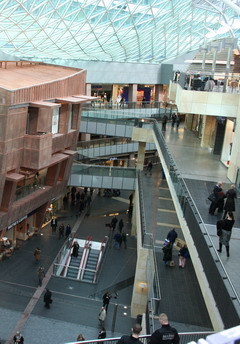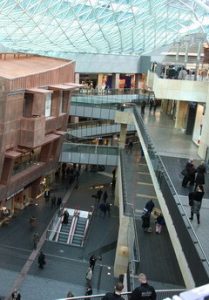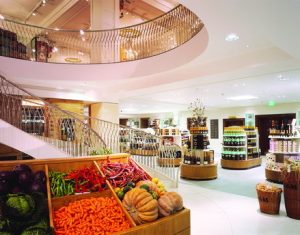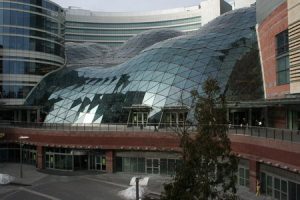There are signs of an economic slowdown in Europe. The U.S. sub-prime mortgage crisis is registering around the world and the direction of European bank action and available credit is uncertain. But that hasn’t slowed the pace of new retail development. With the triennial EuroShop taking place this month in Düsseldorf, Germany, now is a good time to take a look at what’s new in some of the old countries.
The U.K.
Much of the new retail action is taking place here. Even pricey Regent Street, in the center of London, seems to have become the must-be location for retailers looking to make their mark on the capital.
One of the more innovative new arrivals is Desigual, a Barcelona-based fashion retailer that has opened a Regent Street flagship. The store may have a small frontage but it’s capturing the attention of almost every passing shopper. Clothes lines, strung across the entrance and adorned with white T-shirts (printed up with the message “I ♥ Desigual”), act as the curtain-raiser for a large atrium. Inside is a floor-to-ceiling video screen with content that includes fashion shows and music stars. In the hide-bound Edwardian surroundings of Regent Street, this is a very loud shout.
The neighborhood is also the setting for Abercrombie & Fitch’s first European venture. Housed in a former branch of the Bank of England, this has all the hallmarks familiar to North American visitors, including very low levels of ambient light. However, this space has a few added tricks, such as a mounted moose head, emblematic of the brand, and a nightclub-style atmosphere.
On nearby Oxford Street, Uniqlo has opened a flagship store, a statement that – its previous difficulties in Europe notwithstanding – this Japanese retailer is here to stay. A lightbox on the ground level, looking like an oversized Pantone card, dominates the space, suggesting all the options available for cashmere sweaters. A wall of plasma screens alternates those Pantone colors with film of Japanese fashion models.
Advertisement
At the other end of Oxford Street, Irish discount fashion chain Primark has opened a two-floor, 80,000-square-foot shop that aims to prove that value doesn’t have to feel cheap. Dark wood detailing around the perimeter, a central escalator well with blue neon tubes recessed into the ceiling, and a semi-standalone lingerie shop where glass screens with black baroque appliqués allow views in and out make the store appear more upscale than it is.
Most exciting for the Queen and Britain’s other foodies is the food hall of department store Fortnum & Mason, which has been completely refurbished. A huge, circular, polished filigree steel and marble staircase sweeps customers down to a white space that puts custom fixturing, a beautifully crafted series of deli counters and a stripped-wood wine bar all in view. Visitors standing at the bottom of the staircase can stare up through the four floors above, catching a hint of the luxury that pervades this space.
But not everything new in the U.K. is in London. Coventry, a small city in the middle of England, has scored the world’s only in-town IKEA store. To accommodate the urban location’s 258,000-square-foot selling area, the Swedish retailer built up rather than out. The store is housed in a building with a three-level parking garage at its base and three floors of shopping space above. This is a trial for IKEA – if it works, expect large multi-floor downtown stores to begin appearing elsewhere.
Finally, entertainment retailer HMV has launched a trial store in Dudley, in Birmingham’s hinterland, aimed at stemming the flow of customers away from traditional music stores to online alternatives. Its stark, black-and-white interior features gaming areas, a juice bar, free Internet access and a high-gloss, white-rafted ceiling set against a black background. The movie-house-style cashwrap area references the brand’s heritage.
France
Advertisement
The opening of a standalone BHV men’s shop in the Marais quarter provides an example of why a visit to Paris is rarely wasted. A vertical garden adorns the exterior. The interior reinvents the selling of menswear, with each floor providing a different “universe,” ranging from a fake log forest on one level to the stock exchange feel of the jeans department on another, where the prices of individual items are shown on screens, trading floor-style.
Austria
Middle Europe is generally notable more for the streamlined efficiency of its retail concepts than for innovation. But Interspar’s 48,000-square-foot hypermarket in the Murpark shopping mall in Graz-Leibenau gives the well-tried format a decent reworking. The store allows large amounts of ambient light into the interior and then boosts this with color-filtered spotlights that produce a different atmosphere for each of the large service counters. It also uses an integrated spraying system on the fish counter, soaking the stock every 20 seconds and keeping it fresh and shiny.
Poland
Mention should also be made of the high-profile shopping centers rising out of the ground at the other end of the Continent. The most awe-inspiring of these during the last year is Zloty Tarasy (“Golden Terraces”), a series of giant polyhedrons formed of more than 4000 triangular pieces of glass pulled together by a geodesic frame. Shoppers stand and gawk at the exterior and prove equally inspired by the multi-level retail development, much of it covered in copper mesh, which lies within. ING Real Estate, the multinational developer, won the International Centre of the Year award for this project.
Green Continent
Advertisement
Retailers across Europe have been falling over themselves to prove they’re greener than their rivals. European design consultancies now include some form of eco-element whenever they’re creating supermarkets or fashioning a new store for the British retailer, Marks & Spencer. An M&S “eco-store” opened in September in Bournemouth, on the south coast of England. It looks like any other of the retailer’s recently refurbished stores. The difference is in the low-energy lighting, the use of an atrium to preserve the store’s internal temperature and the deployment of recycled materials in its fit-out, among many other things. This is all likely to become an everyday part of the M&S store blueprint.
Increasingly, European consumers – just as those in the U.S. – are looking to retailers to be more environmentally responsible as a matter of corporate hygiene. Doubtless, EuroShop visitors will be treated to endless designs, displays and materials to help pursue this particular eco-friendly trend. Europshop runs from Feb. 23-27, in Düsseldorf.


 Headlines1 week ago
Headlines1 week ago
 Photo Gallery1 day ago
Photo Gallery1 day ago
 Headlines2 weeks ago
Headlines2 weeks ago
 Headlines2 weeks ago
Headlines2 weeks ago
 Sector Spotlight1 week ago
Sector Spotlight1 week ago
 Headlines1 week ago
Headlines1 week ago
 Headlines1 week ago
Headlines1 week ago
 Headlines3 days ago
Headlines3 days ago


















